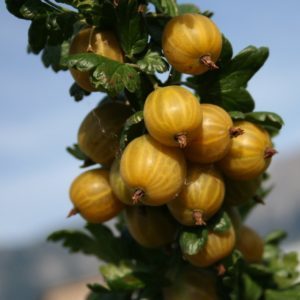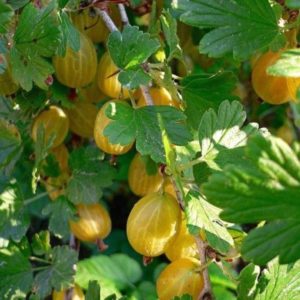Sweet, frost-resistant gooseberry variety "English Yellow"
English yellow is an unpretentious gooseberry variety. Due to its frost resistance and ability to adapt to different climatic conditions, the crop is grown almost everywhere. In the article you will find a detailed description of the English yellow gooseberry variety, information about its pros, cons and cultivation features.
What kind of gooseberry is this?
This is a mid-season gooseberry variety - the berries reach technical maturity in mid or late July. The bushes bear fruit annually for 10-12 years, starting 3-4 years after planting. Productivity – 8-12 kg per bush or 15 t/ha.
The harvest is harvested in 2 stages. Fully ripened berries are stored at a temperature of +2°C for 5 days, and fruits collected a week before full ripening are stored for a month at 0°C and 3 months at -2°C.
Brief history of origin and distribution
The history of the origin and breeding of the English yellow gooseberry is unknown. At the same time, there is information that in the middle of the 20th century this variety was one of the most popular in the territory of the former USSR.
Characteristics and description of bushes
The bushes are medium-sized (up to 1.5 m high), slightly spreading, with thin, erect shoots, along the entire length of which there are soft, long, single thorns. The bark on young shoots is gray with a purple tint; on branches older than 2 years it is brown.
The leaves are medium-sized (up to 3 cm in length and width), leathery, dark green in color, and acquire a purple hue at the end of summer.Leaf blades are 3- or 5-lobed with blunt teeth along the edges.
The flowering period occurs at the end of May and lasts 5-7 days. At this time, small, narrow yellowish-white bisexual flowers appear on the bushes.
Temperature resistance
The bushes tolerate air temperatures down to -20°C. When grown in regions with harsher and less snowy winters, they need shelter.
Moisture and drought resistance
The variety tolerates drought well, but does not tolerate waterlogging of the soil - this can cause rotting of the root system and cracking of the berries.
Resistance to diseases and pests
The variety is characterized by persistent immunity to diseases and pests. But if the rules of plant care are violated, the bushes are affected by the following diseases:
- anthracnose;
- American powdery mildew (sphere library);
- columnar rust;
- sawfly larvae;
- spider mites;
- shoot aphid;
- moths.
Characteristics and description of fruits
The berries are medium-sized, weigh 3-5 g, but some specimens reach a weight of 8 g, are oval in shape, covered with a dense, glossy, lightly pubescent skin of a bright yellow color, which becomes amber after full ripening.
The pulp is yellow, juicy and sweet, with slight sourness and a subtle, barely perceptible aroma.
Areas of their application
The fruits of English yellow are consumed fresh, used for making sauces, fruit salads, jams, compotes, marmalade, juices and making liqueurs and amber dessert wine.
In folk medicine, a decoction of gooseberry leaves is used to treat pneumonia, and the berries are used as a choleretic agent.
Important! Gooseberries of this variety are not frozen, because after defrosting their taste deteriorates.
Advantages and disadvantages of the variety compared to other varieties and hybrids
The main advantages of English yellow:
- high productivity;

- excellent taste and beautiful color of berries;
- drought and frost resistance;
- good keeping quality and transportability;
- good immunity;
- compactness of the bushes, facilitating harvesting;
- lack of tendency to shedding.
Disadvantages of the variety:
- cracking of berries in case of high humidity;
- presence of thorns;
- unsuitable for freezing;
- almost complete absence of aroma;
- low resistance to American powdery mildew.
Growing technology
Growing this gooseberry is not difficult. The main thing is to choose the right seedlings, as well as the time and place for planting them.
Optimal conditions
To plant English yellow, choose a well-lit place, protected from gusty winds and drafts, with a soil depth of at least 1 m.
The variety prefers fertile, light soil with a neutral acidity level, good moisture and air permeability. The best option is black soil and loams.
A month before planting, the area is cleared of weeds and plant debris, dug up with a shovel and for every 100 square meters. m add 20 kg of compost or rotted manure, 5 kg of potassium salt and 20 kg of phosphate rock.
Reference. Lime, ash or dolomite flour is added to acidic soil at the rate of 15 kg per 1 sq.m.
When purchasing seedlings, choose 1- or 2-year-old specimens with 1-2 shoots 30-50 cm long, uniform bark without cracks, strong, developed and branched roots 12-17 cm long without rot and dry areas.
Immediately before planting, the roots of the seedlings are soaked for a day in a solution of growth stimulants (Kornevin, Heteroauxin, Vympel, Zircon) for better rooting and protection from diseases and pests.
Landing dates and rules
English yellow is planted in spring (late March) or autumn (late September).
Landing rules:
- 2 weeks before planting the seedlings in the prepared area, dig planting holes measuring 50x50 cm every 1-1.5 m.
- Fill them one third with a nutritious soil mixture - 3 parts fertile soil, 2 parts complex mineral fertilizers and 1 part sand.
- Form a hill from the nutrient mixture in the center of the hole, place the seedling on it, carefully straightening its roots.
- Cover the seedling with soil so that there are no voids and the root collar is flush with the ground or 1-3 cm higher.
- Water the seedlings generously at the rate of 10 liters of water for each.
- Mulch the soil with compost or rotted manure.
- Trim the shoots so that there are 5-6 buds left on each.
Further care
The bushes are watered in a special ditch 10-15 cm deep, dug around the bush 60-70 cm from the roots 3 times per season: at the end of May - beginning of June, in mid-July and at the end of September (before frost).
Reference. Water consumption for a bush under 3 years old is 20 liters, for an adult plant – 30-40 liters.
Fertilizers are applied three years after planting the bushes according to the following scheme:
- early spring - 5 kg of manure or compost, 15 g of potassium sulfate and urea and 25 g of superphosphate per 1 sq. m;
- before flowering - 20 g per nitrophoska per 1 sq. m;
- during fruiting (June - early July) - watering with slurry;
- after 7-15 days - 1 kg of ash in the tree trunk circle.
Bushes begin to form from the first year, when planting, cutting off shoots to 5-6 buds, and after the leaves fall, leaving up to 3 branches on the bushes. A year later, 6 shoots are left, the branches of the current year are shortened by a third. For the 3rd year, 4 young basal shoots are selected, the young ones are shortened. Bushes at the age of 7 years should consist of 20 branches of different ages.
During sanitary pruning, all broken, damaged, frozen branches and those with signs of disease are removed.
To prevent the development of diseases and pest attacks, the bushes are sprayed before flowering:
- wood ash – dissolve 450 g in 10 liters of hot water and leave for 2 days;
- ash-soap solution - dissolve 50 g of soap and 1.3 kg of ash in 10 liters of water, leave for 48 hours.
Possible problems, diseases, pests
Diseases and pests that affect English yellow are presented in the table.
| Disease/pest | Description | Treatment |
|---|---|---|
| Shoot aphid | The insect feeds on shoots and leaves. The leaf plates curl, the tops are deformed, new shoots are practically not formed, and burgundy seals appear on the leaves. | If the number of insects is small, the bushes are treated with an infusion of garlic, tansy, and tomato tops. In case of severe damage, chemical agents are used: “Aktara”, “Fufanon”, “Fitoverm”, “Sumitsidin”, “Karbofos”, “Aktellik”. |
| Spider mite | Light spots appear on the leaves, and cobwebs appear on the lower part of the plates. | Bushes process acaricides (“Akartan”, “Cidial”, “Tedion”), sprayed with a solution of colloidal sulfur. |
| Ognevka | Moth caterpillars eat flowers, ovaries, and berry pulp. They turn yellow and dry out prematurely. A thin web forms on the fruits. | Plants are sprayed with ash water, infusion of tomato tops or mustard solution.If traditional methods do not help, use the drugs “Karate”, “Iskra”, “Kinmiks”. |
| Anthracnose | Small brown spots appear on the leaves at the bottom of the bushes, the leaves fall off, new shoots do not grow, and the yield drops. | The bushes are sprayed with Bordeaux mixture and Kuprozan and Phthalan preparations 4 times (before and after flowering, 2 weeks after the end of fruiting and after harvesting). |
| American powdery mildew | A powdery coating forms on the leaves growing on the tops of the shoots, which over time turns into brown spots with black dots, the bushes develop slowly, the berries crack and fall off. | At the beginning of spring, the bushes and the soil under them are doused with water (+50°C); before and after flowering, the plants are sprayed with Topaz, Skor or Fundazol. |
| Columnar rust | Yellow spots appear on the inside of the leaves, the foliage withers and falls, the berries become deformed and dry. | The bushes are treated three times with Bordeaux mixture or sprayed twice with Bayleton. |
Wintering
At the end of September, the bushes are watered abundantly (60-70 liters of water for each) and treated with Bordeaux mixture. The ground is cleared of plant debris and loosened.
In the northern regions, the shoots are tied into 1 bundle with twine or twine, bent to the ground, secured with special brackets or boards, covered with dry leaves and covered with spruce branches or burlap.
Reproduction
English yellow reproduce in several ways:
- Cuttings. Mature lignified shoots are cut into several parts and germinated. The method allows you to obtain an unlimited number of seedlings.
- By layering. Use horizontal layering older than 3 years. From one mother bush, 5 young seedlings are obtained that do not lose varietal qualities.
- Dividing the bush.In autumn or early spring, an adult bush is dug up and divided into 2-3 parts.
Features of growing this variety depending on the region
When growing the variety in the northern and eastern regions, characterized by long, frosty (with temperatures below -20°C) and little snow, the bushes must be covered. In areas with milder climates this is not necessary.
Pollinator varieties
English yellow is a self-fertile gooseberry variety and does not require additional pollinators.
Reviews from summer residents
Gardeners leave positive reviews about the English yellow gooseberry.
Vera, Suzdal: “When I was choosing which variety to plant on the plot, I settled on English yellow because of the beautiful color of the berries. I harvested it 3 years after planting the seedlings and was pleasantly surprised by the taste of the fruits - they are very sweet, honey-like. The bushes didn’t hurt in any way, although I don’t carry out preventive treatments.”
Andrey, Vladikavkaz: “The main value of this variety for me personally is its unpretentiousness, because I often don’t have enough time to care for the garden. I prune English yellow in the spring, then water it 2-3 times and that’s it. The bushes develop and bear fruit well, the yield is high. The berries are delicious, we eat them fresh and use them to make jam and wine.”
Conclusion
English yellow is a popular gooseberry variety among gardeners. Among its advantages, especially high yield, excellent drought and frost resistance, pleasant taste, keeping quality and marketable quality of the berries are highlighted.